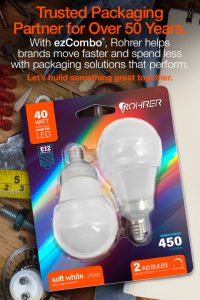According to Forbes, “Accelerating the growth of innovation in emerging industries—the speed to market of potentially game-changing products and technologies—is vital to long-term economic competitiveness. In fact, being able to design and manufacture high-potential products quickly is critical to revitalizing manufacturing in the United States.” What does decreased speed to market mean to brand owners? Early in the project, we had discussions with the client, who wanted the cleaning cloth to be placed at the bottom of the package, under the bottle of liquid cleaning fluid. We told them that, while not a production problem, it would cause the package to be top-heavy and fall over on-shelf.Other issues came up. The package design called for a footed blister pack that could stand on its own, and that could be either front or back facing. Putting more pressure on the timeline, the client was installing a new machine—the one selected to run the blister pack on. We had to document the machine’s capabilities and the feasibility of our design. This required different approaches that were articulated through prototypes. The solution was an innovative “jigsaw” pattern on front and back blisters so they could be mated without excessive thickness. We tested the auto-feed to ensure that it worked without interruption and were ready for full production runs in time to meet our speed-to-market mandate.The result? A key time saver in the development of this LCD cleaning kit package was the decision to position the cloth above the cleaning fluid bottle for better stability.
Early in the project, we had discussions with the client, who wanted the cleaning cloth to be placed at the bottom of the package, under the bottle of liquid cleaning fluid. We told them that, while not a production problem, it would cause the package to be top-heavy and fall over on-shelf.Other issues came up. The package design called for a footed blister pack that could stand on its own, and that could be either front or back facing. Putting more pressure on the timeline, the client was installing a new machine—the one selected to run the blister pack on. We had to document the machine’s capabilities and the feasibility of our design. This required different approaches that were articulated through prototypes. The solution was an innovative “jigsaw” pattern on front and back blisters so they could be mated without excessive thickness. We tested the auto-feed to ensure that it worked without interruption and were ready for full production runs in time to meet our speed-to-market mandate.The result? A key time saver in the development of this LCD cleaning kit package was the decision to position the cloth above the cleaning fluid bottle for better stability.
- Slower speed to market gives the competition the edge when it comes to innovation, allowing them to reach consumers with new products, services or offers ahead of you
- When you get hung up on too many iterations or the existing machinery isn’t up to the job, you give other brands an opening to dominate the market, even with a substandard product, simply because they got out there first
- Risks putting you in the “follower” position for a long time to come
The Retailer Sets the Rules
The large retail chains set the rules of the game, and they can change them on you at any time. So, make sure you and your packaging partner know all the details of their requirements. When possible, bring the retailer into the loop, and be prepared to be agile with your strategy and resources.How Saying “No” Delivered a Big “Yes!”
Insignia™, an electronics brand, approached us with a short deadline project for packaging a computer screen cleaning kit. Our first step was to do a thorough evaluation. This included review of the following:- Retailer specifications
- Photos of the product
- Packaging specs and review of machinery; it’s important to produce “forgiving design” to ensure that packaging components will work on machines currently in use
 Early in the project, we had discussions with the client, who wanted the cleaning cloth to be placed at the bottom of the package, under the bottle of liquid cleaning fluid. We told them that, while not a production problem, it would cause the package to be top-heavy and fall over on-shelf.Other issues came up. The package design called for a footed blister pack that could stand on its own, and that could be either front or back facing. Putting more pressure on the timeline, the client was installing a new machine—the one selected to run the blister pack on. We had to document the machine’s capabilities and the feasibility of our design. This required different approaches that were articulated through prototypes. The solution was an innovative “jigsaw” pattern on front and back blisters so they could be mated without excessive thickness. We tested the auto-feed to ensure that it worked without interruption and were ready for full production runs in time to meet our speed-to-market mandate.The result? A key time saver in the development of this LCD cleaning kit package was the decision to position the cloth above the cleaning fluid bottle for better stability.
Early in the project, we had discussions with the client, who wanted the cleaning cloth to be placed at the bottom of the package, under the bottle of liquid cleaning fluid. We told them that, while not a production problem, it would cause the package to be top-heavy and fall over on-shelf.Other issues came up. The package design called for a footed blister pack that could stand on its own, and that could be either front or back facing. Putting more pressure on the timeline, the client was installing a new machine—the one selected to run the blister pack on. We had to document the machine’s capabilities and the feasibility of our design. This required different approaches that were articulated through prototypes. The solution was an innovative “jigsaw” pattern on front and back blisters so they could be mated without excessive thickness. We tested the auto-feed to ensure that it worked without interruption and were ready for full production runs in time to meet our speed-to-market mandate.The result? A key time saver in the development of this LCD cleaning kit package was the decision to position the cloth above the cleaning fluid bottle for better stability.Want a Packaging Partner with Speed-To-Market Savvy? Make Sure They Can Answer These Questions
- How would you address the issues that drive time to market, such as:
- New competition that threatens my market share?
- Declining sales?
- What are the constraints that might slow down the process and how would you manage them?
- What manufacturing equipment and processes will you use to bring my product to market?



